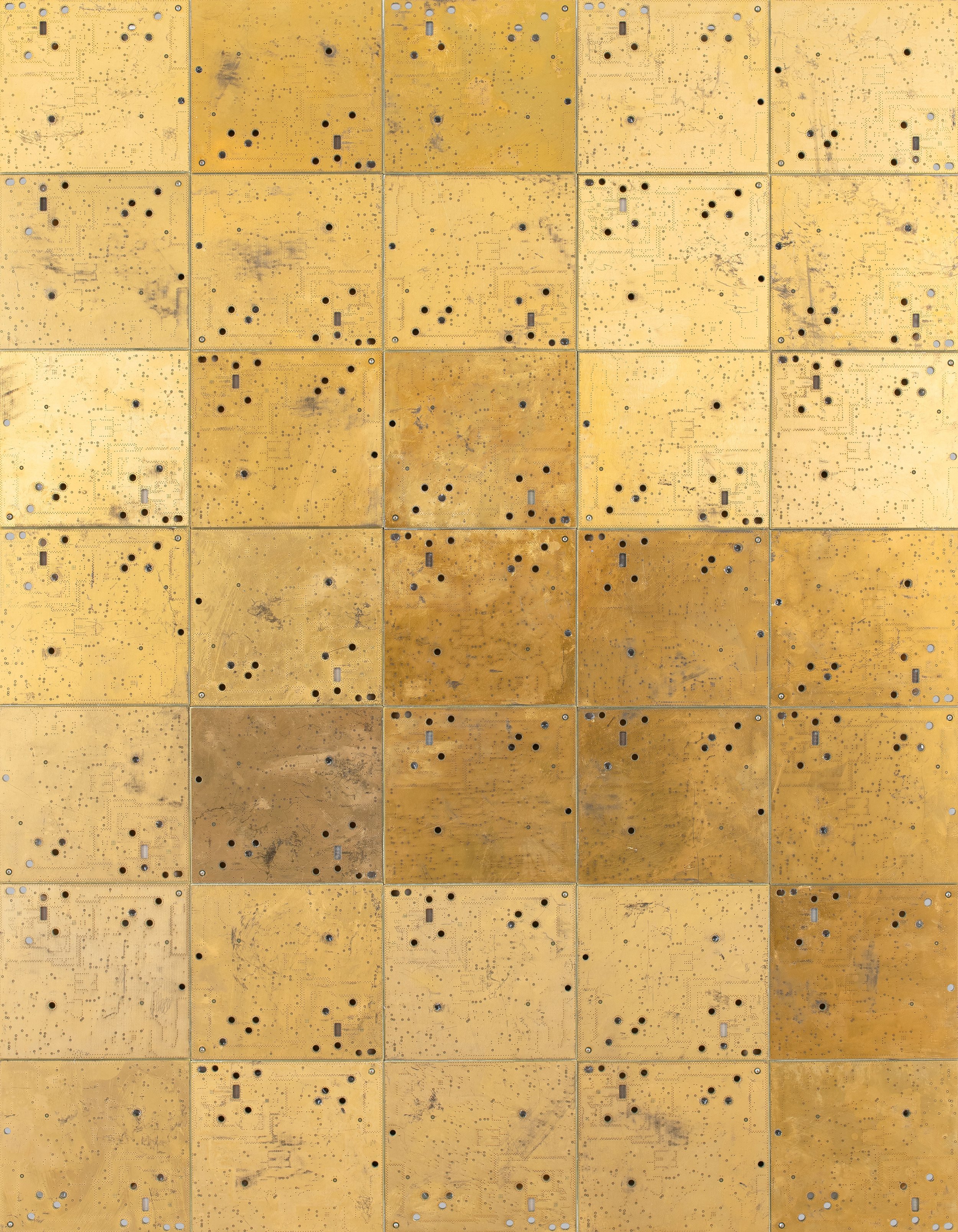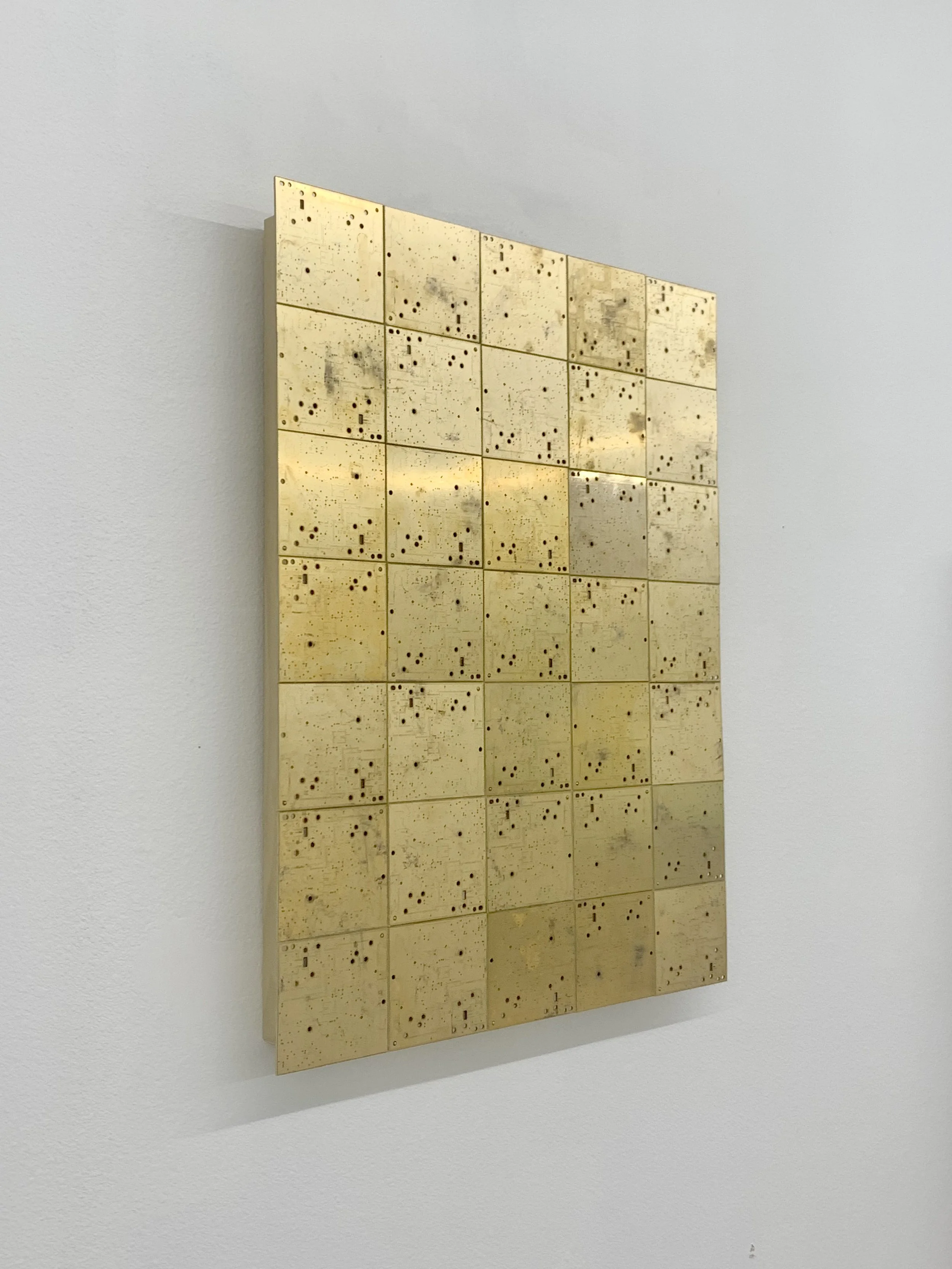Mapping, 2021
Mapping, 2021
Circuit board mounted on wood panel
25 x 19.5 inches / 63.5 x 49.5 cm
A circuit board serves as the architectural framework of a computer's functioning mind, operating on the core principle of manipulating on-and-off signals to execute logical operations. It mechanically supports and interconnects electronic components, facilitating the flow of these signals. Each hole and engraving etched onto a chip carries its own significance. In Mapping (2021), a collection of thirty-five found circuit boards is reimagined as an operational map spliced together. Arranged to evoke an astronomical pattern, the sculptural landscape mirrors a night sky filled with stars. By displacing the functional markings of the circuit boards, the engravings coalesce into random, abstract patterns. Through this assemblage, Mapping examines the functional essence of digitization while simultaneously creating a visual representation of the universe shaped by randomness and chance.
Q: What prompted your interest in the motherboard topic?
Tan Mu: From a young age, I have been fascinated by circuit design and even took courses that introduced me to the logic patterns and governing principles of the physical world. These experiences not only deepened my appreciation for technology but also sparked a lasting curiosity about the structured yet boundless possibilities of physics. What particularly captivated me was the concept of logic circuits—systems that achieve complex functionalities by manipulating signal switches. At the heart of these systems lies the motherboard, the backbone of computing, which orchestrates these intricate processes. My interest extends beyond just the technical aspects; I am deeply intrigued by the history of computing and how advancements in hardware, such as motherboards, have directly driven the exponential growth of computational power. The continuous evolution of these technologies is not just about making machines faster, more efficient, and more powerful—it is a reflection of human ambition, pushing the boundaries of what is possible. Each breakthrough in motherboard design contributes to a larger narrative of progress, shaping the way we innovate and leaving behind a shared legacy of technological achievement.
Q: What drew you to showcase the back side of the motherboard—the hidden, golden circuitry—as the primary surface of Mapping?
Tan Mu: I chose to highlight the backside of the motherboard—the concealed, golden circuitry—because it unveils an often-neglected yet vital structure: the silent network that underpins functionality. Each solder point and marking on this golden surface represents hidden signal pathways, component pins, solder joints, and power layers, revealing the intricate connections that sustain the system. In contrast, the front side, adorned with complex logic circuits, chips, and components, embodies the familiar elements of computation. The relationship between the front and back is akin to a three-dimensional puzzle—everything on the back exists to support or connect what lies on the front, much like an invisible force shaping reality. By bringing this hidden layer to the forefront, I aim to alter perception, transforming something purely functional into something poetic. These golden traces, typically unseen, resemble celestial constellations when reexamined, blurring the boundaries between technology and nature, the digital and the cosmic. In Mapping, this inversion challenges how we interpret meaning within structures, inviting viewers to contemplate the invisible forces that govern technology. It is an attempt to visualize the hidden logic of digitization while embracing the unpredictability and abstraction that arise from it.
Q: What does the connection between the circuit boards' function and their representation of the night sky mean to you?
Tan Mu: The traces on the back of the motherboard reveal the most efficient pathways determined by computation, and visually, they resemble landscapes and star maps. This juxtaposition—between the romantic imagery of a night sky and the hardware that powers our digital reality—evokes humanity’s vision of technology and emotion within the grand scale of the future. This theme also appears in my other works, such as the Signal series, which explores the physical infrastructure of submarine cables.
If we think of our home planet as a motherboard, then submarine cables function like logic pathways connecting megacities—akin to solder points on a circuit board. Through precise calculation, they navigate the complexities of natural geological formations on the seabed and the constraints of labor and cost, determining the most efficient routes. These hidden infrastructures, much like the intricate traces of a motherboard, form an interconnected web that mirrors constellations.Just as we push technology to surpass its current limits, striving for faster and more powerful computation, we also dream of transcending our home planet to explore the cosmos. Though we have yet to leave Earth entirely, we continue to imagine that breakthrough moment. These starry visions offer a poetic perspective—our eyes turn to the sky, seeking guidance and hope in the vast universe. Art exists to capture and express this indescribable, collective longing.





